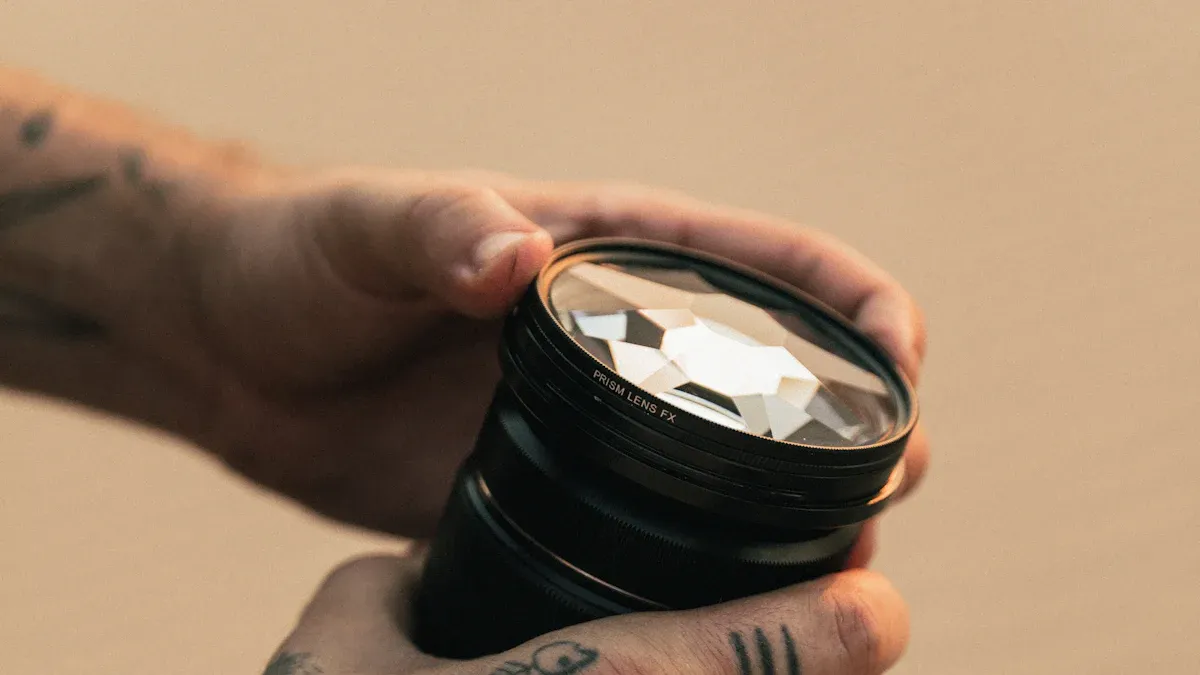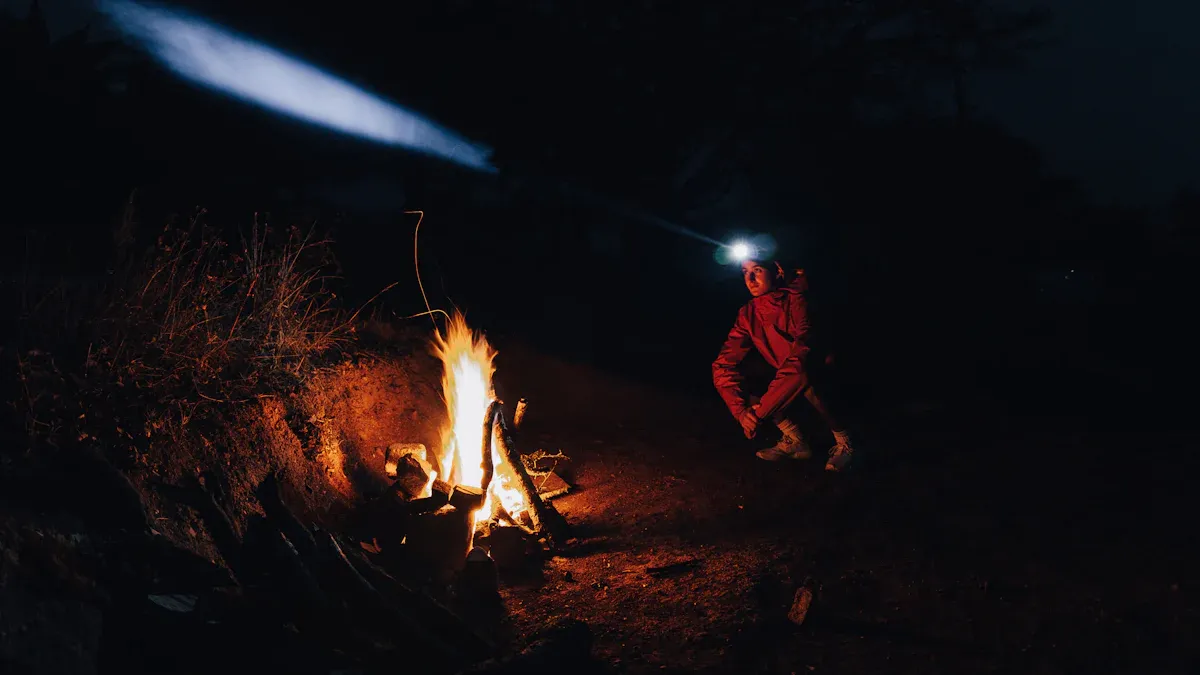Headlamp vs Flashlight A Simple Guide to Making the Right Choice

When it comes to lighting tools, you’ve got two main options: headlamps and flashlights. A headlamp keeps your hands free, making it perfect for hiking, camping, or even night gardening. On the other hand, the helius flashlight offers unmatched precision and portability, ideal for tasks requiring focused beams or long-distance illumination.
Key Takeaways
Headlamps let you use both hands while lighting up. They are great for hiking, camping, or fixing things.
Flashlights are easy to carry and give focused light. They work well for tasks needing bright or far-reaching beams.
Think about battery life and type. Rechargeable ones save money for daily use. Disposable batteries are better for emergencies.
Key Features of a Headlamp and Flashlight

Hands-Free Lighting with a Headlamp
A headlamp is your go-to tool when you need hands-free lighting. Whether you're camping, working on a DIY project, or exploring a dark trail, it keeps your hands free to focus on the task. The adjustable straps make it versatile, fitting snugly on your head for comfort during long use. You can also adjust the beam to get the perfect angle and brightness for your activity.
Headlamps are designed for safety and efficiency. Imagine trying to fix something in the dark while holding a flashlight—it’s tricky, right? With a headlamp, you can handle tools or operate machinery without juggling a light source. This reduces accidents and makes your work smoother. Plus, their durability ensures they can handle rugged environments like construction sites or outdoor adventures.
Precision and Portability of a Flashlight
When you need precision, a flashlight is the better choice. Its compact size and lightweight design make it easy to carry in your pocket or backpack. Despite its small size, a high-quality flashlight can pack a punch. For example, some models offer up to 1,200 lumens of brightness, allowing you to see clearly in the darkest conditions.
Flashlights also excel in beam distance. Some can project light up to 328 meters, making them ideal for spotting distant objects. Many modern flashlights even come with features like OLED displays for battery life and brightness adjustments. These features make them user-friendly and perfect for tasks requiring focused illumination.
Feature | Description |
|---|---|
Compact Size | Easy to carry in pockets or backpacks. |
Lightweight Design | Portable without adding extra weight. |
Up to 1,200 lumens for superior visibility. | |
Long Beam Distance | Illuminates areas up to 328 meters away. |
User-Friendly OLED Display | Provides real-time battery and brightness information. |
Wireless Charging | Convenient charging without specific cables. |
Comparing Battery Life and Power Options
Battery life is a key factor when choosing between a headlamp or flashlight. Rechargeable headlamps often provide consistent brightness but may have shorter runtimes. On the other hand, disposable battery-powered headlamps last longer in emergencies since you can quickly swap out batteries.
Rechargeable batteries are cost-effective in the long run. They can last for hundreds of cycles, saving you money over time. Disposable batteries, however, are great for long-term storage. They can last up to 10 years, making them ideal for disaster preparedness. Flashlights and headlamps both use similar power options, including rechargeable lithium-ion batteries and disposable alkaline batteries.
Tip: If you need a reliable light source for emergencies, consider a model with disposable batteries. For daily use, rechargeable options are more economical and eco-friendly.
Choosing for Outdoor Activities

Hiking and Camping with a Headlamp
When you're out hiking or camping, a headlamp becomes your best friend. It offers hands-free convenience, allowing you to focus on walking or hiking without juggling a light source. This is especially helpful when you're making camp or navigating uneven trails in the dark. A general purpose headlamp provides high wearing comfort, so you can wear it for hours without discomfort.
Why choose a headlamp for hiking and camping?
Hands-free operation gives you maximum freedom of movement.
Adjustable straps ensure a snug fit, even during long treks.
The beam angle can be adjusted to suit your needs, whether you're setting up a tent or cooking dinner.
With a headlamp, you can enjoy the functionality and safety it brings to outdoor adventures. It’s a reliable tool for working in the dark, ensuring you’re prepared for any situation.
Running or Cycling at Night
Running or cycling at night requires a reliable light source to keep you safe. A headlamp is a great choice here, as it provides a dynamic first-person view. You’ll see hazards like potholes or debris more effectively. Pairing a headlamp with a bike light enhances your visibility and ensures you’re seen by others.
Key benefits of a headlamp for night activities:
Lightweight and secure straps stay in place during vigorous movement.
Rear-facing red lights improve visibility for others on the road.
Adjustable brightness levels help you adapt to changing conditions.
Tip: For added safety, choose a headlamp with multiple light modes, like strobe or SOS, to signal danger if needed.
Fishing or Hunting: Headlamp or Flashlight?
Fishing and hunting demand specific lighting needs, and choosing between a headlamp or flashlight depends on your activity. A flashlight offers tactical precision, making it ideal for spotting distant targets. However, a headlamp provides comfort and hands-free functionality, which is essential when handling gear or bait.
What to look for in a light source for fishing or hunting:
Light Range: A long beam distance helps you see far ahead.
Durability: Waterproof and dustproof designs withstand tough outdoor conditions.
Light Modes: Low-power for saving battery, boost for maximum brightness, and SOS for emergencies.
Comfort: A headlamp should fit well and be easy to adjust, even with gloves.
Whether you choose a headlamp or flashlight, ensure it meets your needs for brightness, quality, and power supply. Both options can enhance your experience, but a headlamp often excels in versatility for extended use.
Choosing for Home Use
DIY Repairs and Maintenance
When tackling DIY repairs or maintenance tasks, having the right lighting can make all the difference. A headlamp is a game-changer here. It keeps your hands free, so you can focus on the job without juggling a light source. Whether you're fixing a leaky pipe under the sink or working on a car engine, a high quality headlamp ensures you have consistent and adjustable lighting.
The beam angle of a headlamp can be adjusted to illuminate tight spaces, making it perfect for intricate tasks. Its durability also means it can handle the occasional bump or drop. If you prefer a more focused light for precision work, a flashlight might be a better fit. However, for most home repairs, the functionality of a headlamp makes it the ideal choice.
Power Outages: Headlamp or Flashlight?
Power outages can leave you scrambling for a reliable light source. Should you choose a headlamp or flashlight? It depends on your needs. A headlamp offers hands-free convenience, allowing you to move around freely while keeping your hands available for other tasks. This is especially useful when you're searching for candles, resetting circuit breakers, or preparing food.
On the other hand, a flashlight provides a focused beam, which is great for inspecting specific areas or signaling for help. A general purpose headlamp is often the better option for prolonged use during outages, thanks to its comfort and versatility. Whichever you choose, ensure it has adjustable brightness levels and a dependable power source.
Gardening or Yard Work After Dark
Gardening or yard work after dark becomes much easier with a headlamp. Its hands-free operation lets you multitask, whether you're planting flowers, trimming hedges, or clearing pathways. You can adjust the brightness to suit delicate tasks, like pruning or checking for pests.
A headlamp is also ideal for other nighttime activities, such as checking fences or organizing outdoor spaces. Its quality and functionality ensure you can work efficiently, even in low-light conditions. For extended use, opt for a headlamp with a comfortable strap and long battery life.
Tip: Choose a headlamp with waterproof features if you often work in damp or rainy conditions.
Choosing for Professional Tasks
Construction and Trades
If you work in construction or trades, you know how important proper lighting is for safety and efficiency. A headlamp can be your best survival headlamp when you're working in the dark or in tight spaces. It keeps your hands free, so you can focus on tools and materials. On the other hand, a flashlight offers tactical precision for inspecting specific areas or equipment.
Different tasks require different lighting solutions. Here’s a quick comparison of common work lights:
Lighting Type | Description |
|---|---|
Portable Light Towers | Tall, movable lights that provide wide coverage and can be solar or battery-powered. |
Balloon Lights | Inflatable lights that diffuse light to reduce glare and shadows, enhancing safety at night. |
High Mast Lights | Semi-permanent lights mounted on tall poles, providing extensive illumination but less portability. |
Equipment-Mounted Lights | Lights attached to machinery for improved visibility in specific work areas. |
For smaller tasks, headlamps and flashlights are more practical. Look for models with weather-resistant designs and brightness levels over 2,000 lumens for outdoor use. Rechargeable options are also great for long shifts.
Medical and Emergency Services
In medical and emergency services, every second counts. A headlamp is a game-changer here. It provides hands-free functionality, letting you focus on critical tasks without holding a light. The beam follows your line of sight, offering super bright, targeted illumination for procedures or quick assessments.
Key benefits of a headlamp in this field include:
Hands-free operation for increased efficiency.
Durable, waterproof designs for unpredictable conditions.
Long runtime to last through extended shifts.
Adjustable beams for multi-functional use.
Flashlights, while useful, don’t offer the same level of convenience in emergencies. A high-quality headlamp ensures you’re always prepared, whether you’re treating patients or navigating challenging environments.
Technical or Mechanical Work
When working on projects like car repairs or machinery maintenance, lighting can make or break your performance. A flashlight is often the better choice for technical work. Its focused beam provides precision, especially for inspecting small parts or tight spaces. However, a headlamp can also be useful for hands-free tasks, like holding tools or adjusting components.
Here’s what to consider:
Flashlights excel in tactical precision but may lack comfort for prolonged use.
Headlamps offer versatility but can feel tight during long sessions.
Choose a light with adjustable brightness and a compact design for maximum functionality.
Whether you pick a headlamp or flashlight, prioritize quality and durability. Both options can enhance your work, but the right choice depends on your specific needs.
Factors to Consider When Choosing
Duration of Use
How long you plan to use your light source plays a big role in your decision. If you’re working in the dark for extended periods, you’ll want a device with a long battery life. Rechargeable options are great for daily use, but disposable batteries might be better for emergencies since they last longer in storage.
For activities like night hiking or fishing, a headlamp is often the better choice. It keeps your hands free and provides consistent lighting for hours. Flashlights, on the other hand, are ideal for shorter tasks or when you need a quick burst of tactical precision. Always check the runtime of your device to avoid unexpected outages.
Tip: Look for models with battery indicators. They’ll help you monitor power levels and plan recharges or replacements.
Brightness Levels and Beam Distance
The brightness and beam distance of your light source determine how well you can see in different conditions. A narrow beam travels farther, making it perfect for spotting objects at a distance. However, you’ll sacrifice nearby illumination.
Here’s a quick guide to brightness levels and their uses:
Lumens | Distance | Best For |
|---|---|---|
1–250 | Up to 80m | Everyday tasks like reading or walking in dim light. |
160–400 | Up to 100m | Camping, hiking, and general outdoor activities. |
400–1000 | Up to 200m | Backpacking, caving, or engine repairs. |
1000–3000 | Up to 350m | Fishing, hunting, or rock climbing. |
3000–7000 | Up to 500m | Emergency rescue or extreme weather conditions. |
Choose a headlamp or flashlight based on your activity. For example, a headlamp with 400 lumens is great for hiking, while a flashlight with 1000 lumens works well for tactical tasks like hunting.
Comfort and Ease of Use
Comfort matters, especially if you’ll be using your light for long periods. A headlamp should have adjustable straps and padding to prevent discomfort. Flashlights, on the other hand, should be lightweight and easy to grip.
Here are some factors to consider:
Factor | Description |
|---|---|
Brightness and Lumens | Adjustable levels let you adapt to different tasks. |
Battery Life and Power | Rechargeable or disposable options; indicators prevent surprises. |
Comfort and Fit | Adjustable straps and padded sections improve headlamp comfort. |
Waterproof and Durability | Essential for outdoor use in rain or tough conditions. |
Additional Lighting Modes | Features like strobe or red light add versatility for emergencies or night activities. |
If you’re working in the dark or tackling outdoor adventures, prioritize comfort and durability. A well-fitted headlamp or ergonomic flashlight can make all the difference.
Choosing between a headlamp and a flashlight depends on your needs and preferences. Each has unique advantages that make it suitable for specific tasks. Here's a quick comparison to help you decide:
Feature | Headlamps | Flashlights |
|---|---|---|
Brightness | Some can shine as bright as car headlights. | Spotlight-style flashlights are the brightest. |
Form Factor | Mounted on the head, allowing hands-free use. | Handheld, requiring manual operation. |
Durability | Less durable due to plastic housing. | Often built to be more durable and versatile. |
Beam Angles | Fixed point of light, less adjustable. | Can be maneuvered for different angles. |
Tech Trends | Features like reactive lighting for auto-adjustment. | Unique tech like rechargeable batteries. |
Price | Generally more expensive than flashlights. | Typically less expensive due to simpler design. |
Portability and Convenience: A headlamp offers hands-free illumination, while a flashlight provides flexible positioning.
Comfort and Wearability: Headlamps are designed with adjustable straps for comfort, while flashlights are lightweight and easy to carry.
Tip: For hands-free convenience, go with a headlamp. If you need precision and portability, a flashlight is your best bet.
FAQ
What’s the best light source for hiking at night?
A headlamp is your best bet. It keeps your hands free and provides consistent lighting, making it easier to navigate trails and set up camp.
Can I use a flashlight for running or cycling?
You can, but a headlamp works better. It stays secure on your head and lights up your path without needing to hold it.
How do I choose between rechargeable and disposable batteries?
Rechargeable batteries save money over time and are eco-friendly. Disposable ones are better for emergencies since they last longer in storage.
See Also
Selecting The Perfect Headlamp Flashlight For Your Needs
Essential Factors To Consider When Buying A Headlamp
A Detailed Guide To Selecting The Best Home Flashlight
A Beginner's Guide To Selecting The Ideal Hunting Flashlight
